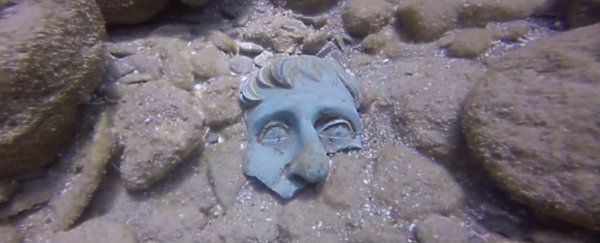A pair of divers have uncovered a massive underwater treasure trove, replete with bronze statues, intricate figurines, and thousands of coins, hidden inside a 1,600-year-old merchant shipwreck in the ancient harbour of Caesarea, Israel.
The artefacts, which bear the sigils of the Roman empire, represent the largest cache of such treasures found in Israel in more than 30 years, and have stunned archaeologists with their "extraordinary state of preservation".
"These are extremely exciting finds, which apart from their extraordinary beauty, are of historical significance," Jacob Sharvit, director of the Marine Archaeology Unit of the Israel Antiquities Authority, told the press.
According to Reuters, the haul includes a bronze lamp depicting the image of the Sun god Sol, a figurine of the Moon goddess Luna, and a lamp shaped like the head of an African slave.
There are fragments of life-sized bronze cast statues, figurines of animals, including a whale and a wild boar with the head of a swan, and lumps of coins weighing a total of 20 kilograms, bearing the images of Roman emperors Constantine and Licinius.
 Israeli Antiquities Authority
Israeli Antiquities Authority
 Clara Amit, courtesy of the Israel Antiquities Authority
Clara Amit, courtesy of the Israel Antiquities Authority
"A marine assemblage such as this has not been found in Israel in the past 30 years. Metal statues are rare archaeological finds because they were always melted down and recycled in antiquity," said Sharvit.
"In the many marine excavations that have been carried out in Caesarea, only very small number of bronze statues have been found… The sand protected the statues; consequently they are in an amazing state of preservation - as though they were cast yesterday rather than 1,600 years ago," he added.
Some of the objects have been dated to the 4th century, while others are thought to come from the 1st and 2nd centuries, the Associated Press reports.
Divers Ran Feinstein and Ofer Ra'anan from the Israeli city of Ra'anana located the merchant shipwreck a few weeks ago, and archaeologists have been carefully recovering them ever since.
"It took us a couple of seconds to understand what was going on," Ra'anan told the Associated Press, adding that when they found their first sculpture, they left it in the seabed to investigate the area further, and once they found a second, they knew they were on to something extraordinary.
"It was amazing. I dive here every other weekend and I never found anything like that ever," he said.
The treasures are now safely on land and under the care of the Israel Antiquities Authority, whose staff will prepare them for examination and conservation treatments.
 Israeli Antiquities Authority
Israeli Antiquities Authority
